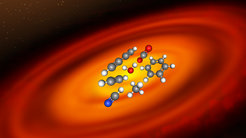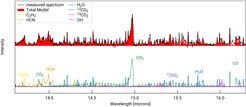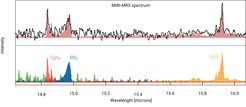JWST peeks into the birthplaces of exoplanets
Astronomers excited by first JWST spectra of planetary cradles showing a rich and diverse chemistry
Researchers using the James Webb Space Telescope (JWST) have taken a first look at their data that probe the chemistry of the regions of disks around young stars where rocky planets form. Already at that stage, the data reveal the disks to be chemically diverse and rich in molecules such as water, carbon dioxide, and organic hydrocarbon compounds like benzene as well as tiny grains of carbon and silicates. The JWST observing program MINDS bringing together several European research institutes promises to provide a revolutionary view on the conditions that precede the birth of planets and, at the same time, determine their compositions.

New observations towards a sample of planet-forming disks around young stars obtained with the Mid-Infrared Instrument (MIRI) on board the James Webb Space Telescope (JWST) provide a first look into how this powerful tool will boost our understanding of terrestrial planet formation. The initial results presented in two articles demonstrate the diversity of cradles of rocky planets.
Planet-forming disks range from environments rich in carbon-bearing compounds, including organic molecules as complex as benzene, to agglomerates containing carbon dioxide and traces of water. Like fingerprints, these chemicals produce uniquely identifiable markers in the spectra the astronomers obtained with their observations. A spectrum is a rainbow-like display of light or, as in this case, e.g., infrared radiation, splitting it into the colours of which it is composed.
A dry protoplanetary disk

“We can now study the chemical components in those disks much more precisely,” says Sierra Grant, a postdoc at the Max Planck Institute for extraterrestrial Physics (MPE) in Garching, Germany. She is the main author of an article analysing a disk around a young low-mass star. “The warm inner disk around GW Lup appears to be rather dry. While we clearly detected molecules containing carbon and oxygen, there is much less water present than expected,” Grant explains.
A gap around the central star devoid of gas would explain the lack of water. “If that hole extended until between the snowlines of water and carbon dioxide, it would explain why we find so little water vapour there,” Grant says. The snowlines indicate ring-like zones at varying distances from the star where the temperatures drop to values where certain chemical species freeze out. The water snowline is closer to the star than the one for carbon dioxide.
Therefore, if a cavity extends beyond the water snowline, the gas outside this perimeter would still contain carbon dioxide but only little water. Any planet forming there would initially be fairly dry. Therefore, small icy objects like comets from the outer planetary system could be the only substantial source of water. On the other hand, if a planet interacting with the disk were responsible for such a gap, this would suggest that the planet would have accumulated water during its formation.
Rich carbon chemistry in a disk around a very low-mass star

Life seems to require carbon, forming complex compounds. While simple carbon-bearing molecules such as carbon monoxide and carbon dioxide pervade most planet-forming disks, the rich hydrocarbon chemistry of the following disk is quite unusual.
“The spectrum of the disk around the low-mass star J160532 reveals warm hydrogen gas and hydrogen-carbon compounds at temperatures around 230 degrees Celsius,” says Benoît Tabone, CNRS researcher at the Institut d’Astrophysique Spatiale, Paris-Saclay University, France, and the main author of the second study. The strongest spectral signal stems from hot acetylene molecules, each consisting of two carbon and two hydrogen atoms.
Other equally warm gases of organic molecules are diacetylene and benzene, the first detections in a protoplanetary disk, and probably also methane. These detections indicate that this disk contains more carbon than oxygen. Such a mixture in chemical composition could also influence the atmospheres of planets forming there. In contrast, water seems almost absent. Instead, most of the water may be locked up in icy pebbles of the colder outer disk, not traceable by these observations.
A golden age of astronomical research
Astronomers from 11 European countries have gathered in the MINDS (MIRI mid-Infrared Disk Survey) project to investigate the conditions in the inner regions of such disks where rocky planets are expected to form. They take the next step to decipher the conditions of planet-forming disks – a prerequisite to identifying the processes leading to solid bodies, such as planets and comets, that comprise planetary systems.
“We’re impressed by the quality of the data MIRI produced,” says Thomas Henning, Director at the Max Planck Institute for Astronomy (MPIA) in Heidelberg, Germany. He is the principal investigator (PI) of the JWST Guaranteed Time Observation (GTO) program MINDS. “This wealth of spectral lines does not only reveal the chemical composition of the disk material. It also allows us to determine physical conditions like densities and temperatures across and inside those planet-forming disks, directly where the planets grow.” Altogether, the MINDS program will target the disks of 50 young low-mass stars. “We’re eager to learn about the diversity we’ll find.”
Background information
The James Webb Space Telescope (JWST) is the largest, most powerful telescope ever launched into space. It is an international partnership between NASA, ESA and CSA. JWST’s Mid-InfraRed Instrument (MIRI), built by a European consortium of research institutions, is a multi-purpose scientific instrument for infrared wavelengths between 5 and 28 microns. It combines an imaging camera with a spectrograph.
The MINDS consortium consists of the following research institutions: Max Planck Institute for Astronomy, Heidelberg, Germany; Max Planck Institute for Extraterrestrial Physics, Garching, Germany; Université Paris-Saclay, Orsay and Gif-sur-Yvette, France; Leiden Observatory, The Netherlands; KU Leuven, Belgium; Rijksuniversiteit Groningen, The Netherlands; University of Vienna, Austria; ETH Zürich, Switzerland; Université de Liege, Belgium; Centro de Astrobilogía, CSIC-INTA, Villaneuva de la Cañada and Torrejón de Ardoz, Spain; LESIA, Observatoire de Paris, Meudon, France; INAF, Napoli, Italy; Dublin Institute for Advanced Studies, Ireland; UK Astronomy Technology Centre, Edinburgh, UK; Radboud University, Nijmegen, The Netherlands; Space Research Institute, Graz, Austria; SRON, Groningen and Leiden, The Netherlands; Stockholm University Sweden; DTU Space, Lyngby, Denmark; Onsala Space Observatory, Sweden; Amsterdam University, The Netherlands














